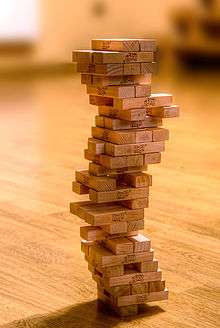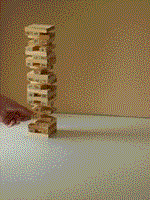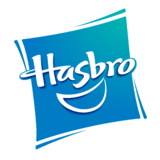Jenga
Jenga is a game of physical skill created by British board game designer and author Leslie Scott, and currently marketed by Hasbro. Players take turns removing one block at a time from a tower constructed of 54 blocks. Each block removed is then placed on top of the tower, creating a progressively more unstable structure.
| Designer(s) | Leslie Scott |
|---|---|
| Players | 2 or more |
| Setup time | < 2 minutes |
| Playing time | Usually 5–15 minutes |
| Random chance | None |
| Age range | 6 and up |
| Skill(s) required | Manual dexterity, eye–hand coordination, precision, strategy |
Rules
Jenga is played with 54 wooden blocks. Each block is three times as long as it is wide, and one fifth as thick as its length 1.5 cm × 2.5 cm × 7.5 cm (0.59 in × 0.98 in × 2.95 in). Blocks have small, random variations from these dimensions so as to create imperfections in the stacking process and make the game more challenging.[1] To set up the game, the included loading tray is used to stack the initial tower which has eighteen levels of three blocks placed adjacent to one another along their long side and at right angles to the previous level (so, for example, if the blocks in the first level lie lengthwise north–south, the second-level blocks will lie east–west).
Once the tower is built, the person who built the tower gets the first move. Moving in Jenga consists of taking one and only one block from any level (except the one below the incomplete top level) of the tower, and placing it on the topmost level to complete it. Only one hand should be used at a time when taking blocks from the tower. Blocks may be bumped to find a loose block that will not disturb the rest of the tower. Any block that is moved out of place must be returned to its original location before removing another block. The turn ends when the next person to move touches the tower or after ten seconds, whichever occurs first.
The game ends when the tower falls, or if any piece falls from the tower other than the piece being knocked out to move to the top. The winner is the last person to remove and place a block successfully.
Origins
Jenga was created by Leslie Scott,[2] the co-founder of Oxford Games Ltd, based on a game that evolved within her family in the early 1970s using children's wooden building blocks[3] the family purchased from a sawmill in Takoradi, Ghana. The name jenga is derived from kujenga, a Swahili word which means "to build".[3] A British national, Scott was born in Tanganyika, where she was raised speaking English and Swahili, before moving to live in Ghana, West Africa. Scott launched the game she named and trademarked as "Jenga" at the London Toy Fair in January 1983[4] and sold it through her own company, Leslie Scott Associates. The blocks of the first sets of Jenga were manufactured for Scott by the Camphill Village Trust in Botton, Yorkshire. The V&A Museum of Childhood has exhibited one of the original sets of Jenga since 1982.[5]
In 1984, Robert Grebler, an entrepreneur from California who was the brother of a close friend of Scott, contacted her and expressed interest in importing and distributing Jenga in Canada. In April 1985, Grebler acquired from Scott the exclusive rights to Jenga for the United States and Canada, and then in October of that year, Scott assigned the worldwide rights in Jenga to Grebler,[6] which he in turn assigned to Pokonobe Associates. Convinced of Jenga's potential, Grebler had invited two cousins to form Pokonobe Associates with him in 1985 to increase distribution of Jenga.[7] Pokonobe then licensed Irwin Toy to sell Jenga in Canada and to be master licensee worldwide. Irwin Toy licensed Jenga to Schaper in the United States and when that company was bought by Hasbro, Jenga was launched under the Milton Bradley banner in 1987.[8] Eventually, Hasbro became licensee in most countries around the world.
As of late 2017, according to Pokonobe Associates, owners of the Jenga brand, over 80 million Jenga games, equivalent to more than 4.3 billion Jenga blocks, have been sold worldwide.
Tallest tower


The packaging copy of one edition of the Jenga game claims that Robert Grebler may have built the tallest Jenga tower ever at 402⁄3 levels. Grebler built the tower in 1985 while playing with an original Jenga set produced by Leslie Scott in the early 1980s.[9]
Official variants
Throw 'n Go Jenga is a variant originally marketed by Hasbro. It consists of blocks that are various colors plus a six-sided die. It is currently marketed by Art's Ideas.
Uno Stacko is Jenga with Uno rules. In this game, the blocks are colored green, red, yellow and blue, numbered from 0 to 9, and there are some action blocks. Each player pulls a block with the color or number of the previously stacked block. When a player stacks a Reverse block, the direction of play is reversed. When a player stacks a Skip block, the next player doesn't pull a block. When a player stacks a Draw Two block, the next player stacks two blocks. When a player stacks a Wildcard block, the player gets to choose which color the next player has to stack.
Jenga Truth or Dare was an adult variation of Jenga also marketed by Hasbro. This version looked like regular Jenga except there were three colors of blocks instead of just the natural color of Jenga.
Jenga Xtreme used parallelogram-shaped blocks that could create some interesting leaning towers.
Casino Jenga: Las Vegas Edition employed roulette-style game play, featuring a felt game board, betting chips, and additional rules.
In addition, there have been a number of collector edition Jenga games, featuring the colors and logos of the Boston Red Sox, Las Vegas Raiders, New York Yankees, and John Deere, among others. Hello Kitty Jenga, Transformers Jenga, Tarzan Jenga, Tim Burton's The Nightmare Before Christmas Jenga, Donkey Kong Jenga, Bob's Burgers Jenga, National Parks Jenga, Jenga Ocean, and The Walking Dead Jenga are some of the licensed variations of Jenga.
Jenga XXL and Jenga Giant are licensed giant Jenga games manufactured and distributed by Art's Ideas. There are Jenga Giant variations which can reach 5 feet (150 cm) or higher in play, with very similar rules.[10] Jenga XXL starts at over 4 feet (1.2 m) high and can reach 8 feet (2.4 m) or higher in play. Rules are the same as in classic Jenga, except players can use two hands to move the eighteen-inch-long blocks.[11]
Jenga Pass Challenge includes a handheld platform that the game is played on. Players remove a block while holding the platform, then pass the platform to the next player. This variant includes only half the number of blocks, 27, which means the tower starts at nine levels high instead of eighteen.
Video games
Jenga World Tour for Nintendo Wii and DS was released by Atari on December 7, 2007. A version of the Jenga game for the Nintendo Wii from Electronic Arts was part of Hasbro's Family Game Night 2 offering.
An iOS version exists, released in late 2010 by NaturalMotion Games. NaturalMotion has also released versions for Android phones and Mac computers.
See also
- Rock balancing
- 56 Leonard Street, nicknamed the Jenga building
- Pick-up sticks, physical game of removing sticks from a pile
Notes
- Mike Danforth & Ian Chillag (August 14, 2015). "Sheep, Spiders, and Jenga". How To Do Everything (Podcast). NPR. Retrieved February 2, 2016.
- Amazing Origins of Timeless Toys, 244
- "Strong National Museum of Play". Strongmuseum.org. 2009-01-20. Archived from the original on 2011-08-07. Retrieved 2010-05-19.
- About Jenga: The Remarkable Business of Creating a Game that Became a Household Name. Leslie Scott (Greenleaf Book Group Press)
- "A personal view from Leslie Scott, the inventor of Jenga | Victoria and Albert Museum". Vam.ac.uk. Archived from the original on 2012-03-06. Retrieved 2012-02-06.
- About Jenga, 108
- Amazing Origins of Timeless Toys, 247
- Amazing Origins of Timeless Toys, 248
- Marketing copy on inside lid of the 2008 Vintage Game Collection edition of Jenga marketed by Hasbro
- "Get To Know The Jenga® GIANT™ Game Rules". Jenga GIANT official website. Retrieved 2019-09-26.
- "Jenga". Jenga.us.com. Retrieved 2012-02-06.
References
- Walsh, Tim (2004). The Playmakers: Amazing Origins of Timeless Toys. Keys Publishing.
External links
| Wikimedia Commons has media related to Jenga. |
